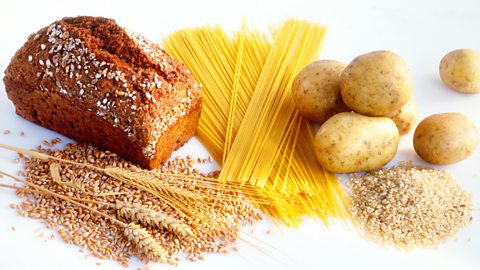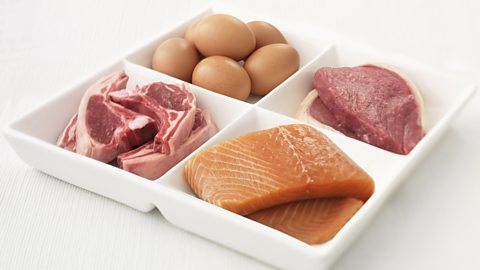Human growth
For healthy growthThe process of increasing in physical size, eg increase in mass or height. and development humans require a balanced dietA diet that contains the correct amounts of all the necessary nutrients required for healthy growth and activity..
The major food groups that make up a balanced diet are carbohydrates, fats and proteins.
| Food group | Sources | Function |
| Carbohydrates | Fruit, vegetables, bread, pasta, rice | Provide energy for cell activities |
| Fats | Butter, cream, cheese, meat | Energy storage and insulation |
| Proteins | Beans, eggs, meat, milk | Provide building materials for growth and repair |
| Food group | Carbohydrates |
|---|---|
| Sources | Fruit, vegetables, bread, pasta, rice |
| Function | Provide energy for cell activities |
| Food group | Fats |
|---|---|
| Sources | Butter, cream, cheese, meat |
| Function | Energy storage and insulation |
| Food group | Proteins |
|---|---|
| Sources | Beans, eggs, meat, milk |
| Function | Provide building materials for growth and repair |



A healthy diet also includes vitaminsOrganic substances which are essential in small amounts to regulate the metabolism and maintain the immune system. and minerals. The lack of a certain vitamin or mineral in the diet can result in a deficiency disease.
| Vitamin | Sources | Function | Deficiency disease |
| A | Dairy products and oily fish | Healthy skin, good vision in low light and strong immune system | Night blindness: difficult seeing in low light conditions |
| C | Wide variety of fruit and vegetables, especially citrus fruits like oranges | Helps maintain cells that give support and structure to the body and helps injuries to heal | Scurvy: tiredness, joint pain, bleeding and swollen gums |
| D | Oily fish and eggs | Helps body to absorb calcium | Rickets (in children): weakening of the bones |
| Vitamin | A |
|---|---|
| Sources | Dairy products and oily fish |
| Function | Healthy skin, good vision in low light and strong immune system |
| Deficiency disease | Night blindness: difficult seeing in low light conditions |
| Vitamin | C |
|---|---|
| Sources | Wide variety of fruit and vegetables, especially citrus fruits like oranges |
| Function | Helps maintain cells that give support and structure to the body and helps injuries to heal |
| Deficiency disease | Scurvy: tiredness, joint pain, bleeding and swollen gums |
| Vitamin | D |
|---|---|
| Sources | Oily fish and eggs |
| Function | Helps body to absorb calcium |
| Deficiency disease | Rickets (in children): weakening of the bones |
| Mineral | Sources | Function | Deficiency disease |
| Calcium | Dairy products, green leafy vegetables like spinach, and nuts | Needed for formation of strong bones and teeth, blood clotting and control of muscle contractions | Rickets (in children): softening and weakening of the bones |
| Iodine | Sea fish, cows’ milk and cereals | Needed by thyroid gland to make hormones that regulate energy release and growth in cells | Goitre: swelling of thyroid gland to create a lump in the throat |
| Iron | Meat, dried fruit and nuts, dark-green leafy vegetables | Needed to make a protein that allows red blood cells to transport oxygen | Anaemia: a decrease in the number of red blood cells means that body cells receive less oxygen and are less able to release energy from food. This results in tiredness and pale skin. |
| Mineral | Calcium |
|---|---|
| Sources | Dairy products, green leafy vegetables like spinach, and nuts |
| Function | Needed for formation of strong bones and teeth, blood clotting and control of muscle contractions |
| Deficiency disease | Rickets (in children): softening and weakening of the bones |
| Mineral | Iodine |
|---|---|
| Sources | Sea fish, cows’ milk and cereals |
| Function | Needed by thyroid gland to make hormones that regulate energy release and growth in cells |
| Deficiency disease | Goitre: swelling of thyroid gland to create a lump in the throat |
| Mineral | Iron |
|---|---|
| Sources | Meat, dried fruit and nuts, dark-green leafy vegetables |
| Function | Needed to make a protein that allows red blood cells to transport oxygen |
| Deficiency disease | Anaemia: a decrease in the number of red blood cells means that body cells receive less oxygen and are less able to release energy from food. This results in tiredness and pale skin. |
Water is also vital for healthy growth and development. All cell reactions happen in solution, and water is used to transport dissolved nutrients and waste products around the body in the blood.